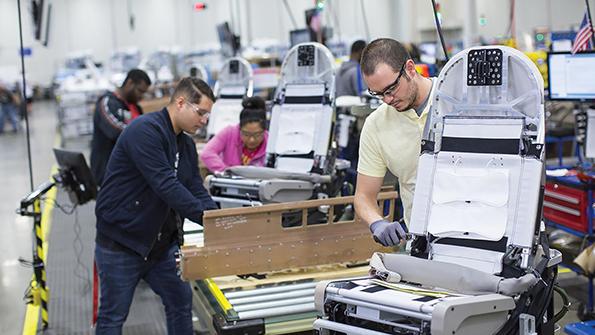
Everything is moving up in aerospace and defense, including the timeline for raising prices.
In October, Raytheon Technologies rolled out its new airliner-part pricing regimen—two months earlier than the giant commercial aerospace supplier and large defense prime traditionally has done when it comes to annual catalog adjustments.
According to financial analysts who have talked with Raytheon’s industry partners, price increases will be in the range of 10-15%, reflecting both current inflation and the additional profit margin targeted by the behemoth, whose 2021 revenue was $64.4 billion. Consumer price index comparisons have been running 8-9% above prior-year comparisons in recent months, so double-digit increases are not surprising.
“The price increase is healthy because it recognizes the fact that costs are going up,” Raytheon Chairman and CEO Greg Hayes told a September investor conference. “That is the one lever that we have.
“It’s not popular with the airlines, but they have seen price increases, and they’re going to see price increases in their supply chain as well,” he added.
So will almost everyone. After more than a generation of tame increases, price spikes could return as a fact of life in aerospace and defense. But will all the higher costs dampen business?
Probably not in the near term, since practically everyone has to pay—and, so far, seems able and willing. Indeed, for key suppliers with pricing power—such as Raytheon, TransDigm International, providers of castings and forgings as well as some others—major price hikes, along with cost savings, are returning to the top of the list of tools to protect profits.
“Price has been the key lever in this environment to pass on costs as productivity is largely capped at 3-5% gains,” analysts from Jefferies say in a recent investor report on TransDigm, famous for its own price ratcheting.
Aftermarket providers can pass on catalog increases more immediately because such sales are more responsive to the spot-market demand. But OEM-oriented manufacturers operate under long-term contracts, and price-sets roll over only annually. For OEM-focused manufacturing, 2023 will be the first window of opportunity to catch up with 2022 cost increases.
There will be pushback, of course, and suppliers expect to have to justify new prices over existing contracts. The Jefferies team found that commercial OEM-oriented respondents in the industry expect gross price increases of only 3.5% and net increases of 3.3% in 2023—levels that the analysts characterize as “likely low,” given that inflation is running in the high single digits lately. Commercial aftermarket providers expect 4.5% gross, 3.5% net.
Even if catalog prices are so restrained next year, many expect that the long-term trend will be up and to the right due to a host of factors. Speaking about inflation on the sidelines of the recent U.S. Chamber of Commerce aerospace summit, Boeing CEO and President David Calhoun reportedly observed that industry is in a “wage-price spiral” and that he sees “five years of trouble” ahead.
At an investor conference in September, Textron Chief Financial Officer Frank Connor said his company was focused on above-inflation price increases even before the pandemic. In recent quarters, the company has enjoyed price increases 1.5% over inflation.
“We were very focused early on on inflation not being transitory and likely to be stickier,” he said. “As we built the backlog that we have, we were very focused on making sure we were maintaining price increases that we believe are in excess of inflation.”
At another investor conference in September, Spirit AeroSystems Chief Financial Officer Mark Suchinski used the analogy of running quickly just to keep up. “Energy and fuel costs are putting a lot of pressure on our cost structure and have had a negative impact on cash” usage, he said. “And we know that the labor markets are tight and that there’s going to be pressure from a labor wage-growth standpoint over the next couple of years.”
On the defense side, prices will rise also, albeit more slowly than in commercial aerospace or the aftermarket. Even when annual consumer price inflation averaged only 2.5% in recent decades, Pentagon leaders across presidential administrations stressed that the defense budget must rise by mid-single digits on top of that every year just to keep up with internal inflationary drivers.
In the end, significant price increases may become the new normal inside the supplier base for the next generation. Well, everywhere except in real prices paid to OEMs for large commercial aircraft—but that is another story for another time.





